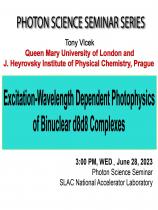Speaker: Tony Vlcek of Queen Mary University of London and J. Heyrovsky Institute of Physical Chemistry, Prague
Program Description:
Excited states of binuclear complexes of d8 metals with bridging isocyanide (RhI, IrI) or pyrophosphite (PtII) ligands originate from dσ*®pσ, dp®pσ, and phosphite®pσ excitations, where σ and p refer to the metal–metal bond. Owing to pσ and dp delocalization, these excitations affect also the ligands, namely the isocyanide groups. Metal-metal bond contraction, long-lived (ns-μs) lowest 3dσ*pσ excited state, slow (ps-ns) intersystem crossing, dual emission, as well as excited-state electron- and atom transfer reactivity are some of the intriguing features of d8d8 photochemistry and photophysics. Time-resolved IR spectra of isocyanide complexes and (stimulated) emission and absorption of [Pt2(μ-P2O5H2)4]4– and its perfluoroborated derivative [Pt2(μ-P2O5(BF2)2)4]4– revealed rich excited-state dynamics that is strongly dependent on the optical excitation energy, molecular rigidity, spin-orbit coupling strength, and the environment. UV-excited high-lying states relax in distinct steps to the lowest triplet state (3dσ*pσ) mostly bypassing the lowest excited singlet (1dσ*pσ). In some cases, optical excitation creates a vibrational wavepacket that oscillates with the metal-metal stretching frequency and is manifested in transient absorption, stimulated emission, as well as in femtosecond Raman and IR spectra. In the case of the Pt complexes, vibrational coherence is transferred from the optically excited 1dσ*pσ state through ISC to the triplet. Upon UV excitation, a coherence transfer over a ~1.5 eV gap takes place within about 300 fs. The stepwise, state-specific deactivation of high-lying excited states of d8d8 binuclear complexes contrasts with smooth femtosecond excited-state evolution reported for octahedral complexes of d6 heavy metals.





